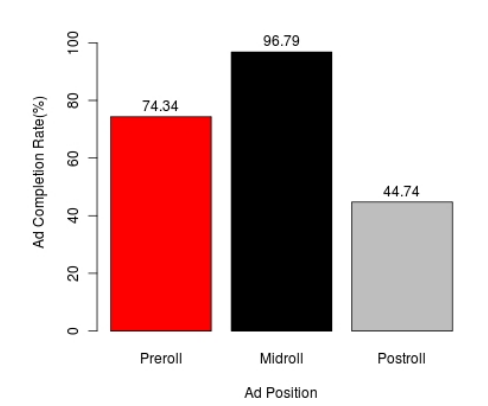Study: Do Consumers Watch Video Ads?
Online Video
October 24, 2013 -- Research out of the University of Massachusetts Amherst tackles the question: How effective are video ads?
“Video usage is growing so rapidly,” says computer science researcher Ramesh Sitaraman, “but making online videos economically sustainable and profitable is a burning question of key importance to the future economics and evolution of the Internet.”
Using the premise that simple, well-accepted measure of ad effectiveness is whether viewers watch the video ads to completion or not, the study looked to understand what factors influence people to complete watching video ads and what contributes to them abandoning ads.
The research analyzed anonymized viewer data --representing real people but without personal information attached-- linked to more than 257 million ads inserted into 367 million videos from over 3,000 publishers and viewed by 65 million unique viewers around the world over a 15-day period in April 2013.
Key findings:
The position in the video where the ad was inserted had the largest impact.
Ads inserted in the middle of a video where viewers are presumably most engaged with the content had the highest ad completion rate (97%), while ads inserted at the beginning or end were completed at lesser rates, 74% and 45%, respectively. The trend held up even after controlling for other factors such as ad length and the video itself where the ad was inserted.

Source: Understanding the Effectiveness of Video Ads: A Measurement Study, 2013
All viewers did not behave similarly.
Viewers who repeatedly came to a particular site had higher completion rates in all ad categories than casual one-time visitors (85% v. 78% overall). “Repeat visitors are likely more interested in the videos offered by that site than one-time visitors, and hence more willing to watch the ads,” says the authors.
The video into which an ad is inserted matters.
Viewers were much more likely to completely watch an ad inserted into long-form content, such as a movie or a TV episode, than short-form content such as a news clip (87% v. 67%). Sitaraman says, “A plausible reason is that viewers assign more uniqueness and value to movies and TV episodes that make it seem more worthwhile for them to sit through an ad.”
Time of day and week -- does it matter for ad watching completion?
Surprisingly, the study found small but not significant variations in ad completion rates due to the time of day or whether its a weekday or the weekend.
Viewers are more patient with ads than with video performance issues.
The study compared two scenarios that could test the patience of a video viewer: One set of viewers experienced a slow-to-load video, while another set watched a pre-roll ad that must complete before the video begins. While both sets of viewers were waiting to watch their chosen video, the viewers watching the slow-to-load ad abandoned more than three times faster as the other group.
Further, at the 10-second mark, more than 45% of viewers waiting for the slow-loading video had abandoned it, compared to only 13% of the viewers abandoning the pre-roll ad. The study surmises a reason for this may be that viewers opt to watch an ad as an implicit form of payment for the content. Waiting for this ad to complete is a predictable experience with a known duration. But a slow-loading video occurs more unexpectedly and the wait is often unknown, causing more frustration and viewer abandonment.
About: The research analyzed data from users in all continents who watched videos and ads over 15 days in April 2013. All major video genres (news, sports, entertainment, movies, TV episodes, etc) were analyzed. The study examined anonymized viewer data linked to more than 257 million ads (75 million minutes of ads in 777 million minutes of videos) inserted into 367 million videos from over 33 video providers and 3,000 publishers and viewed by 65 million unique viewers around the world. Anonymized viewer data, representing real people but without personal information attached, were collected over a 15-day period in April 2013 using Akamai’s media analytics platform which reports anonymized video and ad metrics via ``beacons’’ from millions of actual end-users around the world.
Sources: S.Shunmuga Krishnan and Ramesh Sitaraman, Understanding the Effectiveness of Video Ads: A Measurement Study, accessed Nov. 7, 2013 and UMass Amherst, Researcher Quantifies the Effectiveness of Video Ads, Oct. 24, 2013.





